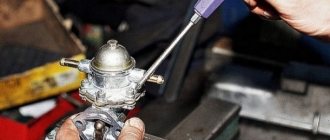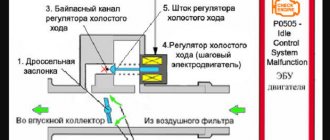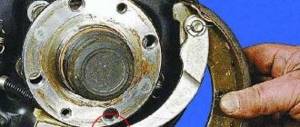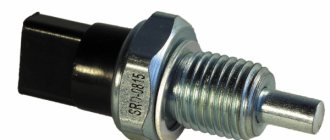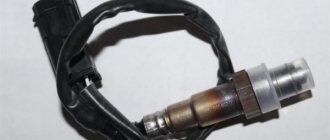An idle speed sensor is installed on the injection VAZ 21099 (2109) in order to speed up the warm-up of a cold engine and reduce wear of rubbing parts when warming up and maintaining idle speed of the engine; its mechanics call it DXX for short. This device is installed in the throttle assembly, which can be seen on the left side of the engine if you look at it from above.
DXX (or IAC is the same sensor
Purpose
The sensor is necessary to regulate the air flow that enters the engine when the throttle is closed. That is, the element automatically regulates the specified engine speed in idle mode. The regulator is also involved in warming up the power unit after a cold start.
Functions
The IAC regulates the amount of air entering the engine when the throttle valve is closed. This suggests that the IAC performs the functions of automatically adjusting the specified engine speed when idling.
The regulator also takes part in the process of warming up the engine to optimal operating temperatures in winter. The operating temperature range of the IAC is quite wide - from -40 to +130 degrees Celsius.
The IAC, despite such important functions, is small in size and consists of three main elements:
- Stepper electric motor;
- Spring;
- A rod with a cone-shaped needle at the end.
The idle speed control is mounted on the throttle body with a pair of screws.
Article on the topic: Selecting and replacing mirrors on a VAZ 2114
IAC location
Device
At the initial stage of development of injection engines, rotor and solenoid devices were used as idle speed regulators. They could have two operating positions - here we can draw an analogy with a shut-off valve. The sensor operated in the fully open or fully closed position. This did not allow the idle speed to be effectively stabilized.
Subsequently, AvtoVAZ engineers created an idle speed sensor for the VAZ-2109 injector in the form of a stepper valve. It is distinguished by the presence of stepwise adjustment of the air supply through a bypass channel in the throttle valve.
The IAC is designed as follows: it is based on a small stepper motor, and the device also contains a rod, a spring and a needle.
Throttle sensor
Until 2011, all tags were equipped with such sensors; the last year of production, an electronic gas pedal could be installed on the car, which performed the function of this device. A throttle position sensor (TPS) is needed to accurately record the throttle opening angle and transmit this information to the engine control unit. The device is mounted on the throttle body and is a simple potentiometer with a resistive plate and a slider. By changing the resistance of the plate, we change the level of the pulse, and the ECU, based on the sensor readings, draws a conclusion about the amount of air entering the manifold. When the throttle is closed, the ECU adjusts the idle speed using the idle speed control.
Symptoms of a problem
Difficulties may arise with self-diagnosis without the use of special equipment, since most of the symptoms of a non-working device are also characteristic of other breakdowns, including loss of compression in individual cylinders. Basically, all the signs of unstable engine operation, incorrect operation in transient modes, floating idle, inadequate response to the movement of the gas pedal are present. However, checking the remote sensing position sensor is quite simple.
How to check
For a working TPS, 5 V is supplied to the positive contact, the negative one goes to ground, and the third contact is used to supply an impulse to the control unit. It is at this pin that you need to check the voltage. You need a multimeter in voltage measurement mode. When the throttle is completely closed, the voltage should be 0.7 V on a new high-quality sensor, on an old one - at least 0.3 V. As the damper opens, the potential increases smoothly and without jerking to 4 V. This is the maximum value when the damper is open. An uneven increase in voltage, discrepancy with the nominal value at the beginning and end of the test is a reason to replace the sensor. Contactless devices have been installed since 2011. They are twice as expensive, but practically did not fail.
Operating principle
When the car is moving and the throttle valve is open, the IAC is not involved in the process, its valve is closed and the rod is motionless. When the damper closes and the engine goes into idle mode, voltage is applied to the electric motor and the rod moves towards the opening - the valve comes into operation. It opens slightly, and air enters the engine bypassing through a special hole.
When the driver turns on the ignition, the IAC rod fully extends to its extreme position and closes the calibration hole in the throttle pipe. The sensor then counts the steps and the valve returns to its home position. As for this basic position, it can be different and depends on the firmware installed in the ECU. For January 5.1 firmware the position is 120 steps, for Bosch firmware it is 50 steps.
Location
Knowing the principle of operation of the VAZ-2109 idle speed sensor (injector), it is not difficult to guess where it should be installed. On this vehicle it is located near the throttle valve and throttle position sensor. The device is fixed with screws on the damper body. In case of failure, the car owner can easily replace it himself.
A little bit of history
The car of the domestic automobile industry, the VAZ 21099 injector, became quite popular even with the release of the first models from the assembly line.
Its main advantages over its brother, the 6th model in terms of popularity, was the use of front-wheel drive and injection power units. The use of such engines has significantly improved the quality of operation of the unit itself and the power has increased accordingly. This is due to more efficient combustion and preparation of the fuel mixture through the use of injection injection systems. And with an increase in efficiency, the quality of the exhaust gases increased. But, even though the engine has an order of magnitude more sensors than a six-wheel engine, problems with its operation still appear from time to time. They may be related to the following factors:
- poor quality fuel;
- a defect in the unit itself, in the engine or in the injector;
- defects caused by ambient temperature and humidity;
- incorrect adjustment of the fuel injection device.
One of the most typical and frequent malfunctions is instability of the engine, from small fluctuations within 100 revolutions to large jumps, even stopping the engine. This malfunction most often begins to appear at sub-zero temperatures, and especially when moving from plus to minus and at high relative humidity.
In this case, condensation forms in all air ducts and cavities, and when the temperature drops, it turns into ice because it does not have time to dry completely. Which in turn leads to sticking of the rod, both the throttle valve itself and the cone-shaped valve of the idle air control. It is also called the XX sensor.
DXX connection diagram
The idle air control is connected with a single four-wire cable. The wire of the VAZ-2109 idle speed sensor is connected to the ECU. Such wiring creates certain problems when trying to diagnose the sensor yourself. You won’t be able to simply apply voltage to the terminal for testing: the ECU supplies voltage to the windings of the stepper motor in pulse mode. Therefore, checking with a multimeter in case of a malfunction is not very effective.
Symptoms of a problem
This element is responsible for the operation of the engine at idle, which means that any malfunction will affect the stability of the idle speed. Among the main symptoms of HPP failure are:
- unstable idle;
- drop in crankshaft speed when additional electrical consumers are turned on;
- absence of increased warm-up speeds during cold starts of the power unit;
- stopping the internal combustion engine when turning off or changing gear.
These symptoms will not always be the cause of a malfunction of the VAZ-2109 idle speed sensor (injector), since the same symptoms will occur if the TPS fails. But if there is a problem with the throttle position sensor, the check engine light will come on. Since the IAC, or idle speed sensor, does not have its own diagnostic system, the lamp will not light up with the same symptoms.
WHAT SIGNS INDICATE A MALFUNCTION OF DXH
Any driver, experienced or novice, should be wary of the unusual behavior of the engine during operation. These may be the following phenomena:
- Unstable operation or complete stop of the motor. Failure to operate when the gas pedal is released;
- When the engine is fully warmed up, the idle speed spontaneously increases and decreases;
- After switching off the gear, the engine stops completely;
- When starting a cold engine, there is no increase in the crankshaft speed;
- When other powerful consumers of electricity are connected, the engine speed drops.
If any of them, or even several signs appear at the same time, you need to pay attention to the performance of the DXH.
HOW TO CHECK THE OPERATION OF DXX
This sensor is not equipped with self-diagnosis elements, like some others, so there will be no signal on the display about its malfunction. On the one hand, this makes it easier to find a faulty unit, but on the other hand, a measuring device is needed to check its functionality. A Chinese digital multimeter is well suited, its cost is low, and it is affordable for any car owner. If you have such a device, then you can start checking its performance.
Checking the idle speed sensor on an injection-type VAZ 2109 is performed as follows:
- The device is placed in position to measure voltage, and the vehicle's on-board network is checked. The device probes installed on the battery terminals should show a voltage slightly more than 12 Volts;
- With the ignition off, disconnect the connector with the wires from the DXX. To do this, you need to press the latch on the plastic housing of the connector with your fingers.
This is clearly visible in the photo on the left. The sensor should only be disconnected or connected when the ignition is turned off to avoid failure of the control unit electronics. The probe of the measuring device is connected to the ground of the machine. Turn on the ignition and use a second probe to check the presence of voltage in the terminals on the connector, which are marked in the photo with the letters A and D. This is clearly visible in the right photo. It must be at least 12 Volts. If it is significantly lower, or is absent altogether, then the culprit may be a break in the supply wires or a failure of the electronics in the motor control unit.
The photo clearly shows where the idle speed sensor is located.
Location of DXX
To remove it, you need to use a Phillips screwdriver and unscrew the two screws securing it.
Removing DXX
- The photo clearly shows the place where the IAC is located. The screw that is closer to the pipe has a “bad habit” of getting lost. To prevent this from happening, first unscrew the left screw. Lightly pull the DXX towards you and unscrew the screw on the right side. In this case, it will remain in the housing hole and will not fall out;
- The measuring device is placed in the position for measuring resistance. The probes are brought to terminals A and B, and then to C and D. The device should show approximately 52 Ohms. This is a working parameter. If you measure the resistance between terminals A and C, and then B and D, the reading should be around infinity. If this is not the case, then the DXX needs to be replaced.
You can also check the DXX “by touch”. They do it this way. With the DX removed, but with the wires connected, you need to lightly press down the protruding part of the cone needle with your finger. When you turn on the ignition, it should push your finger. If there is no shock, the sensor is faulty. There is no longer any doubt that the DX is faulty, so we proceed to replace it.
Before replacing the idle speed sensor on the injection VAZ 21099, a few words about choosing a new IAC. Mechanics who work on such systems speak well of the devices produced by . DXX with the KZTA brand also showed good results. When purchasing the latter, you need to take into account the final mark of the regulator. You need to purchase a sensor with the same mark as on the broken device. The cost of the sensor can range from 500 to 700 rubles. There is a new sensor, you can install it.
The simplest diagnosis of DXX
The easiest way to check the idle speed sensor of the VAZ-2109 is the following method. Need a friend's help. The sensor is disconnected from the connector, then the mounting screws are unscrewed and the device is dismantled. Next, the regulator will be plugged into the connector again, but held in your hands.
At this time, the assistant starts the power unit, and the IAC rod should at this moment retract completely and then extend to a certain distance. If the device behaves this way, then it is operational - the rod is not bent, it is not jammed inside the valve. But there is no guarantee that the device matches the ECU firmware. The rod extends, but the number of steps is unknown. There is a marking on the connector - you can use it to ensure that the ECU sensor matches.
This is the initial stage of diagnosis. Next, check the electrical part, the condition of the valve, and the degree of needle wear.
XX regulation principle
The XX sensor should be called a regulator because it doesn't control anything. But everyone is accustomed to simply calling the entire control circuit assembly a regulator.
Structural scheme
Structurally, the controller circuit can be divided into several functional blocks that perform specific operations:
- controlled;
- manager;
- controlling.
The controlled unit turns on the sensor-motor itself, it opens and closes the air channel.
Sequence of operation of all blocks
The control block is the control circuit. A microcontroller is installed in it, which issues control pulses to the sensor, while controlling the rotation speed. This is carried out by the crankshaft sensor VAZ 21099 injector. Then the controller processes the data received from it and, if necessary, issues the next sequence of pulses.
At the initial moment, when the engine is still cold and not started, the shut-off rod of the XX sensor completely blocks the air duct. And the controller does not produce any pulses. When you turn the key and start the engine, the control unit reads the speed readings from the crankshaft sensor. Since it turns out that there is already rotation, but the valve is not yet open, the controller issues the first impulses to open the air duct. At the same time, it also controls the amount of air consumed using a corresponding sensor.
Then the data from the crankshaft sensor is again read by the controller and it turns out that the speed is lower than required. Then the controller issues the next pulse to the XX sensor, which, having turned another angle, opens the channel more, thereby enriching the mixture better. Consequently, this leads to an increase in the crankshaft speed. When the auxiliary mechanisms reach the set frequency, the controller stops sending pulses to the engine.
With a floating engine speed of a VAZ 21099 car, the injector idle speed sensor most likely has failed, but there may also be a malfunction in the control unit.
Since the diagnostic system of the machine itself is not able to determine the malfunction of the XX sensor, complex measures have to be used. Replace the sensor if replacing the control unit does not help. If the engine roars at full power, but there are no revolutions on the tachometer, then the crankshaft rotation sensor will already be faulty.
How to check a sensor with a multimeter
Using a multimeter, you can diagnose the VAZ-2109 idle speed sensor (injector) in two ways: first, measure in ohmmeter mode, then in voltmeter mode.
If you close the contacts on the CD and AB plugs, the multimeter should show a resistance in the range of 40-80 Ohms. If you close the DC and AD contacts with probes, then the multimeter on a working IAC will show infinity.
In voltmeter mode, the voltage on the sensor when the ignition is on should be 12-20 V.
Diagnostics on the stand
The simplest stands for checking IAC will cost the average car enthusiast 1,500-2,000 rubles. Replacing the idle speed sensor on a VAZ-2109 will cost 300 rubles. Therefore, purchasing a stand is not economically feasible. You can assemble a simple stand with your own hands. The circuit consists of a charger from any mobile equipment with a voltage of 6 V, a plug block and a test lamp. If the lamp lights up during the test, then the IAC is faulty. If the lamp burns at half intensity, then the device is working properly.
How to replace the idle speed sensor
If cleaning does not help and the IAC does not work, then the VAZ-2109 idle speed sensor (injector) needs to be replaced. This is done very simply.
The sensor is installed on the throttle body. It is secured with two screws, just like the fuel pump. To remove, unscrew the mounting bolts and disconnect the plug from the device. Before installing a new DXH, it is recommended to sand the seat.
The new IAC is installed in the same way, in reverse order. The element is installed in place, fixed with bolts, and wires are connected. But sometimes it happens that replacement does not solve the problem, and the idle speed fluctuates even with a new sensor. The reason here is the quality of spare parts in stores - before installation, it is better to make sure that the new sensor is working.
Replacing the idle speed regulator VAZ 21099
The idle speed regulator is responsible for the idle speed of the engine; with its help, the engine is able to maintain the optimal speed required during operation without load to save fuel and increase the service life of the engine's operating mechanisms.
In addition, idling allows the engine to warm up before starting to drive. The idle air control is located on the left side of the throttle assembly and consists of three main components:
- spring - stepper motor - rod with a conical needle at the end
How does the idle air control valve VAZ 21099 work?
The principle of operation of the idle regulator is to open or close a channel. which bypasses the throttle valve. While the engine is running, the crankshaft speed sensor uses special marks to inform the controller about the crankshaft rotation speed (rpm).
The controller, in turn, decides whether to open or close the channel, guided by certain calculations and algorithms. After this, he informs this very IAC about his decision, then the idle speed controller actually executes this command, that is, it increases or, conversely, decreases the fuel supply by extending or retracting the rod with the needle.
Signs of a malfunction of the idle speed control VAZ 21099:
— Unstable engine idle speed (floating idle). — Sudden engine stop when switching to neutral speed. — Increase or decrease speed even on a warm engine. — The speed does not increase after starting a cold engine. — The engine does not start when the gas pedal is pressed. This is a sign that the needle is blocking the channel. — A noticeable drop in engine speed after turning on powerful energy consumers, such as a stove, headlights, etc.).
Attention!
All of the above symptoms can be caused by other components, for example, a faulty coil, spark plugs, fuel pump, fuel filter or other problems related to the fuel supply. Therefore, before changing the idle speed control of the VAZ 2109, make sure that this is really the reason.
You can replace the VAZ 21099 idle air control at a service station, but I would recommend doing it yourself, especially since this work is not difficult.
Replacing the idle speed regulator VAZ 21099 with your own hands
1. First, remove the negative terminal from the battery.
2. After this, disconnect the block with the wires that go to the idle speed control from the throttle pipe; to do this, press the plastic latch.
3. Unscrew the two fastening screws and remove the VAZ 21099 idle speed regulator from the throttle pipe. Sometimes problems arise here, for example, a situation when the fastening screw located closer to the receiver falls out when unscrewing. Taking this into account, I recommend that you first unscrew the left screw located on the left, then pull the idle speed control towards you and unscrew the right screw. This sequence will allow you to remove the idle speed control without losing all the screws, in which case they will remain in the flange.
4. That's all we can say, the independent replacement of the VAZ 21099 idle speed control has come to an end, all that remains is to install a new sensor, this must be done in the reverse order of disassembly. To simplify this operation, it is allowed to drop a couple of drops of engine oil onto the sealing ring.
Now it remains to calibrate the idle speed sensor of the VAZ 21099; this procedure is completely automatic. All you need to do is: — Put on the negative terminal. — Turn on the ignition without starting the engine, 5-10 seconds will be enough. — Turn off the ignition.
That's all the calibration is. The car is ready for use. Let me remind you that in the previous article we told you how to change the boot on the steering rack of a VAZ 21099 with your own hands.
Attention!
If you did not disconnect the battery when replacing the regulator, then you must understand that in this case the ECU will not calibrate the idle speed regulator.
Nuances of choice
The stores offer a huge number of different sensors from different manufacturers. The original part must be marked XX-XXXXXXX-XX. By the last two digits you can figure out compatibility. So, numbers 01 and 03 are interchangeable, and 02 and 04 can also be swapped. Instead of 02, you cannot put 01 or 03. If the sensor is original and new, it is better to additionally lubricate the spring and rod with thick lubricant.
When buying a sensor, even in a trusted store, you should look at the following nuances:
- there are no marks on the packaging by which the manufacturer can be distinguished;
- the sticker on the device body is yellow and has no frames;
- the needle has a dark tip;
- the o-ring is thin and black;
- rivet heads less than 3 mm in diameter;
- white spring;
- The length of the body is 1 mm less than the length of the standard AvtoVAZ sensor.
All these nuances indicate that a counterfeit VAZ-2109 idle speed sensor is being offered. You can see photos of real and fake devices above.
